https://www.youtube.com/watch?v=VSEJiuwQLjI
4 Times Castling In Chess Is Bad

Castle before move 10 .
It's one of the first rules that you're taught as a new chess player .
And it's good advice most of the time .
But there are four specific situations where it's usually the wrong decision to castle .
And in this video , I'm gonna explain what those situations are .
So that when you find yourself in those positions in your games , you'll know to not castle .
Let's get started .
So the first situation in chess when you don't want to castle is when you've already made weakening pawn moves on that side of the board .
So as a reminder , the whole point of Castling is to get your king to safety , you want it to be safe behind a wall of pawns out of the center .
And if that's not happening when you castle , it might not be the right decision .
So for example , if we were to play the move G three , which is a really bad move in this position , and then we'll say black plays D six and white now decides to castle .
This is a big mistake because these weaknesses , uh black is gonna be all over that , right ?
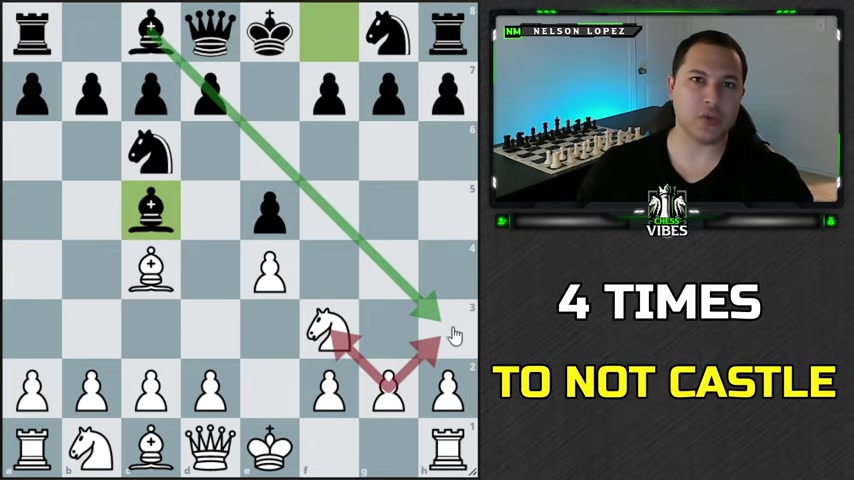
And white is in big trouble right away .
So when white moved this pawn forward , it created weaknesses on these two squares that were not there before .
Right ?
Prior to that , the pawn is controlling everything .
So white can't , I'm sorry , black can't do that .
The pawn will just take the bishop .
So let's talk about these three ponds because um G three is just one example .
F three a lot of times is also bad because it opens up this diagonal and then your kin can be attacked and there's weaknesses on these squares .
And then even H three sometimes can be bad .
Although H three is probably the one pawn that if you're gonna move up pa forward , this is usually OK because these squares are still covered .
And actually a lot of times towards the end of the game , if you're worried about back rank mate H three is a good move to play anyway because it gives your king some breathing room and you have a space to escape to if you need to .
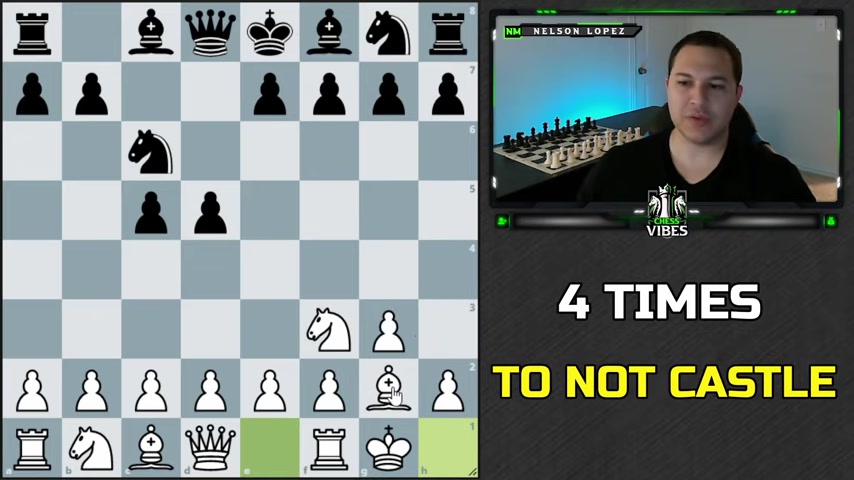
So , so if you do want a castle and the H pond has moved up one square , that's probably OK .
Most of the time you do have to be careful .
Like in this case , the bishops pinning this pawn .
So theoretically black's queen could go there or blacks knight could end up there and , and you couldn't take it because the pin .
So you know , it does create a weakness .
But this is one of the better ones if you have to choose .
And one more thing I'll say about the move G three , you actually see a lot of high level players that will feed and chet the bishop behind the pond .
And this is a very different situation than what I just showed you .
It's perfectly fine to castle here because the bishop fills in the gap where the pawn , you know , has moved forward .
So there's no weaknesses , the bishop is controlling those squares .
So this is an exception to the rule um when it's OK to castle , as long as your bishop is there .
All right .
So the second situation you don't want to castle is if you're going to come under attack by a pawn storm from your opponent .
Now , there's very obvious ways to see this .
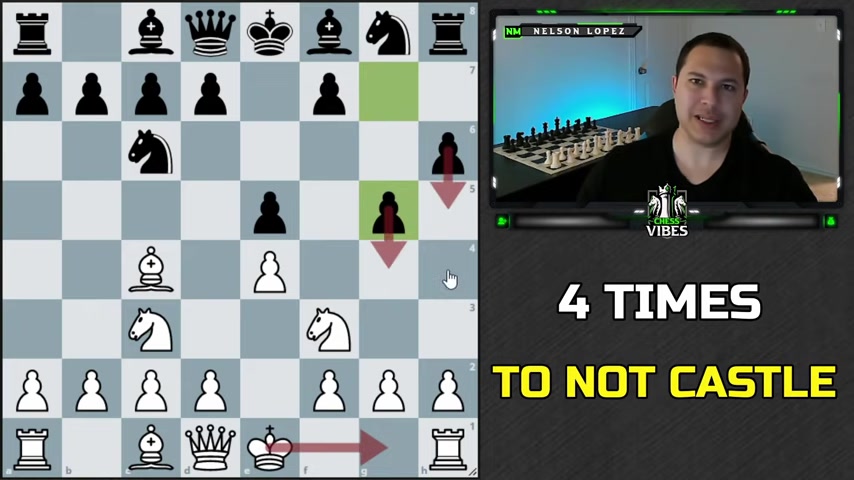
So for example , if my opponent , for whatever reason plays age six and then G five and I'm debating Castling , well , guess what might not be the best idea because I can already see he's pushing pawns to attack my king .
So I'm not gonna castle here .
I'm gonna focus on maybe opening up the center , maybe developing the bishop , uh the queen and castling this way might be something .
So pay attention to pawn storms now .
And most of you are probably thinking , well , nobody just pushes pawns forward like this most of the time .
You're right .
They don't .
But there's a more subtle way that this can happen , that's very dangerous .
So let me , show you another example .
All right .
So here's another example where black has just played bishop to B seven and white is contemplating Castling kings side and white thinks it looks fine .
There's no pawns advanced .
I have no weaknesses .
All my pawns are , you know , controlling everything .
So I'm gonna castle and what black does now is play H six .

And then white's like , OK , I gotta move my bishop and then black plays G five and white's like , OK , I gotta move my bishop again and then black plays maybe G four .
And now white has to move his knight .
And now in this case , night H four is pretty good .
It kind of blockades the position .
Uh But the point here that I want you to take away is that look at how many pawn moves Black got towards White's king all with tempo because white had those pieces that were being attacked .
And so this is something to pay attention to if you have pieces like this , that can be attacked by pawns .
Your opponent is gonna be able to create an attack with tempo and it can be very dangerous because in this case , white didn't have time to , you know , counterattack in the center or finish developing .
They had to move their bishop and again , had to move the bishop .
And now in this case , like if I'm black , I'm probably gonna play like E six first to defend the pawn and then I'm gonna play H five next , let's say knight B and E two H five .
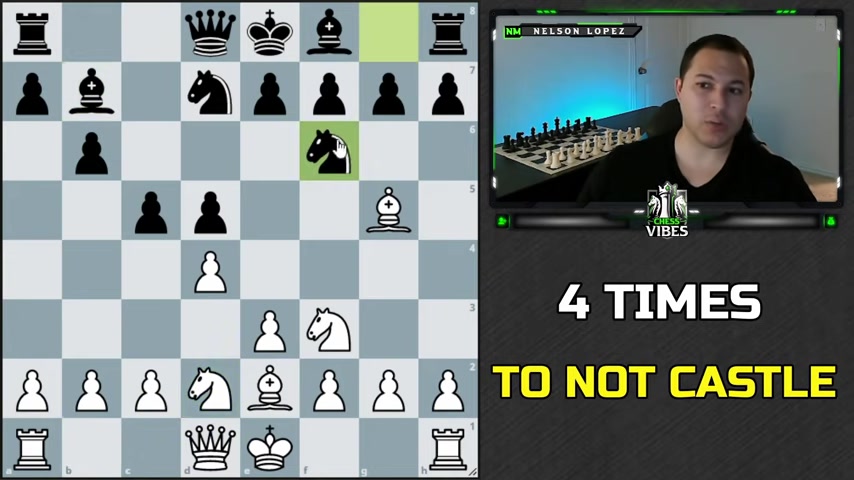
And now White has to be really careful .
I mean , this is a serious attack , right ?
H four is threatening to , to maybe trap the bishop .
Then G four is coming and the knights knock , I can't go there anymore because now the queen and , and White's gonna be probably in trouble .
So right here at this moment when White decided to castle , if I'm playing this position , I'm probably gonna think twice .
And I'm gonna wait , maybe a move or two or maybe I'm gonna play night beat two first .
I'm gonna see what Black does .
Maybe Black will , will go here .
Because now if I Castle and Black plays H Six , I have the option to just trade this off and I don't lose a whole bunch of tempo or whatever it is on my pieces , right ?
So I can take here and then let's say takes and Black can still do this plan .
But now at least I get some time I can go ahead and counterattack in the center .
I have , I have some uh time to do something , right ?
So that's a very subtle difference , but it makes a huge difference in a lot of games .
All right .
Situation .
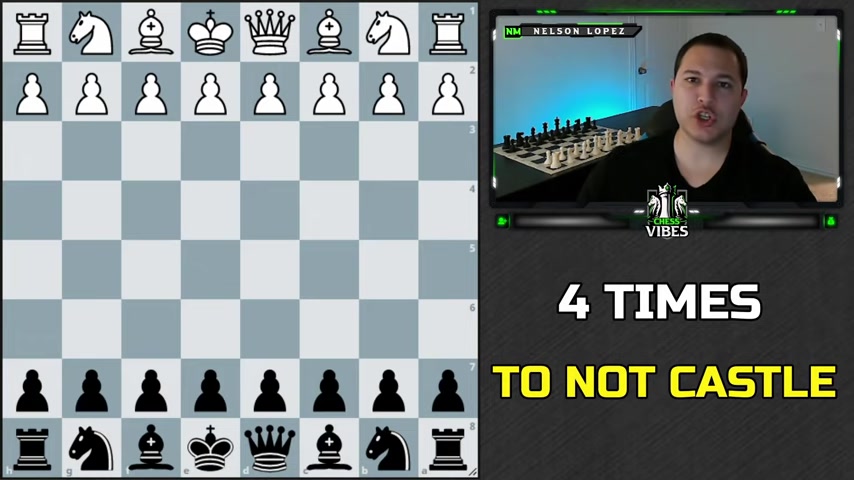
Number three , when you don't want a castle is when your king is actually just safer staying in the center .
So let me show you an example .
Here's the French defense and I don't play the French , but it shows a very good point .
So this is one of the main lines where black trades off .
The bishop brings the night here and then white plays the move queen to G four attacking this pawn on G7 .
Now , one of the main lines that black can play is actually castling .
It's perfectly playable , but the problem is now , black has to really start defending .
OK ?
Because White's gonna play bishop to D three line up over here .
This bishop can come in to G five H four is an option .
The knight can come in .
You know , the queen's already well placed .
It can easily go lots of different places .
And black is gonna have to do some , some defending and try to counterattack over here on the queen side .
But an alternative and another move that is very , very strong .
Is this just the move came to fa and you might say , wow , isn't that like bad ?
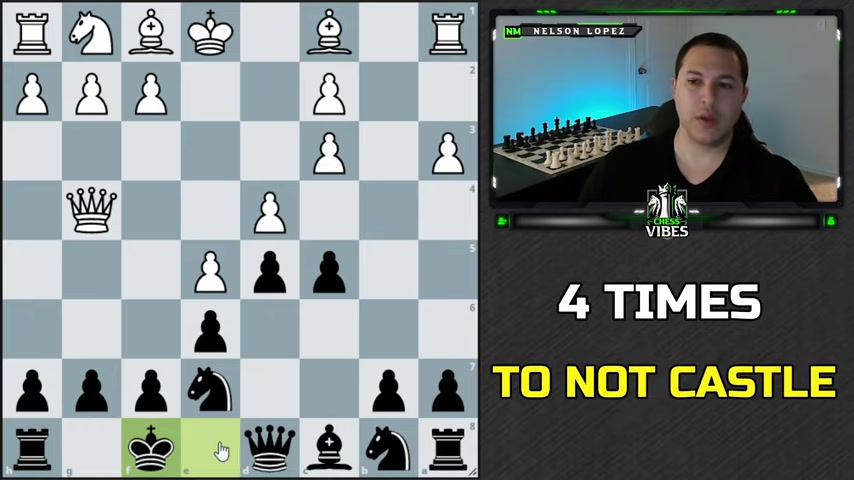
Well , no , it's not because it depends the pond and the center is locked up .
These ponds can't do anything , right ?
So because of that , this is actually , I would say safer for black than castling because if something happens over here where like all these pieces start coming in and you know , whatever black has to get away , you can always move back here and run over here and , and be totally fine .
Go back .
If I had castled here , I can't just move my king over there .
I'm gonna be stuck .
I'm gonna get blocked by my pieces .
II , I have to stay over here and defend and hope for the best .
So the take away sometimes it's better to keep your king in the center or do a move like king F eight because it's safer .
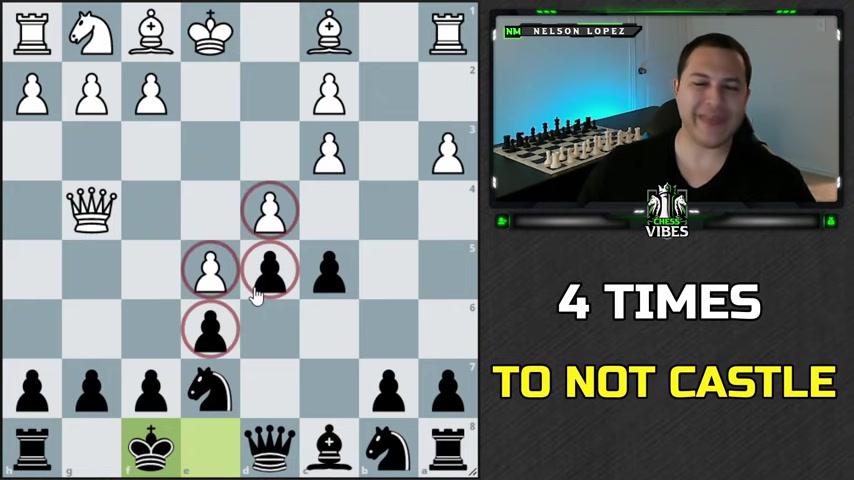
And this is a very case by case basis , this is not a general rule , but in certain situations when the center of the board is locked up , that's when you want to be looking for moves like this sometimes instead of actually castling , right ?
The fourth situation you don't want to castle is if it's going to prevent you from attacking on that side of the board .
So what do I mean , let me show you an example .
I like to play this system against the , the modern defense or against the kings Indian uh where I put both pawns in the center the night on C three and then I play the move F three .
And then after something like this , black castles , I have the option .
If I want , I can just play like bishop C four , bring this night here and then castle king's side .
There's nothing wrong with that totally playable .
But if I do that , uh we'll say black makes some moves , I'm not gonna be able to attack Black's king anymore unless I'm willing to really put my king at risk by pushing these pawns forward .
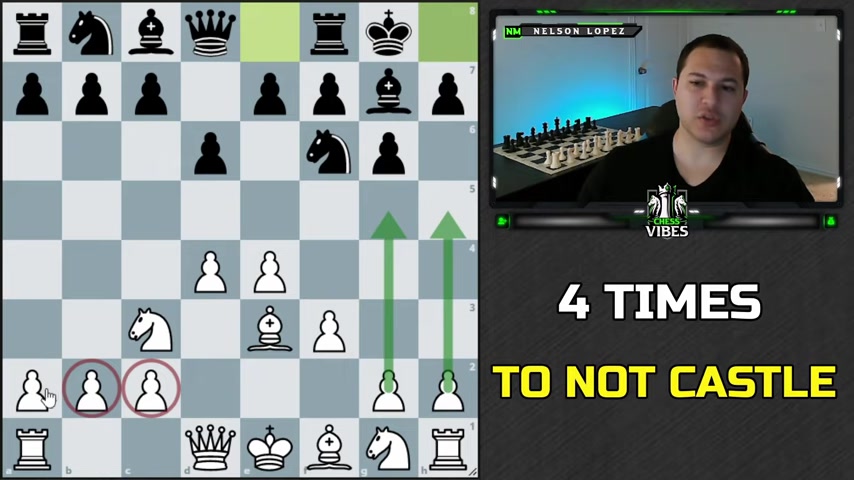
So what I like to do instead of that is not castle here and sometimes I'll castle queen's side .
But a lot of times I just leave the king there and that way I can attack with these pawns and I'm not putting my king at risk .
Right .
I leave the pawns over here .
Uh But by Castling there , I'm essentially saying , OK , I'm not gonna be able to attack on the , on the king side anymore , at least not easily .
So this is kind of a rare situation when , when you're gonna find yourself in these moments .
But it's definitely something you want to keep in mind if you are planning on trying to attack your opponent , like I like to do in the system with moves like G four and H four .
I don't want my king to be over there .
So that's reason number four .
Hey , thanks for watching .
I hope you learned a thing or two about when to not castle in chess as always , stay sharp , play smart .
Are you looking for a way to reach a wider audience and get more views on your videos?
Our innovative video to text transcribing service can help you do just that.
We provide accurate transcriptions of your videos along with visual content that will help you attract new viewers and keep them engaged. Plus, our data analytics and ad campaign tools can help you monetize your content and maximize your revenue.
Let's partner up and take your video content to the next level!
Contact us today to learn more.